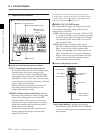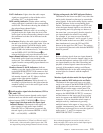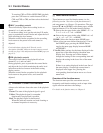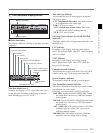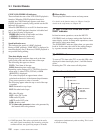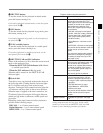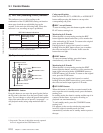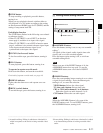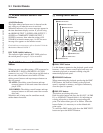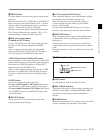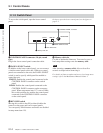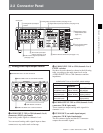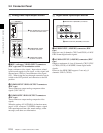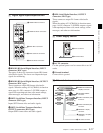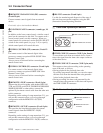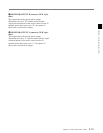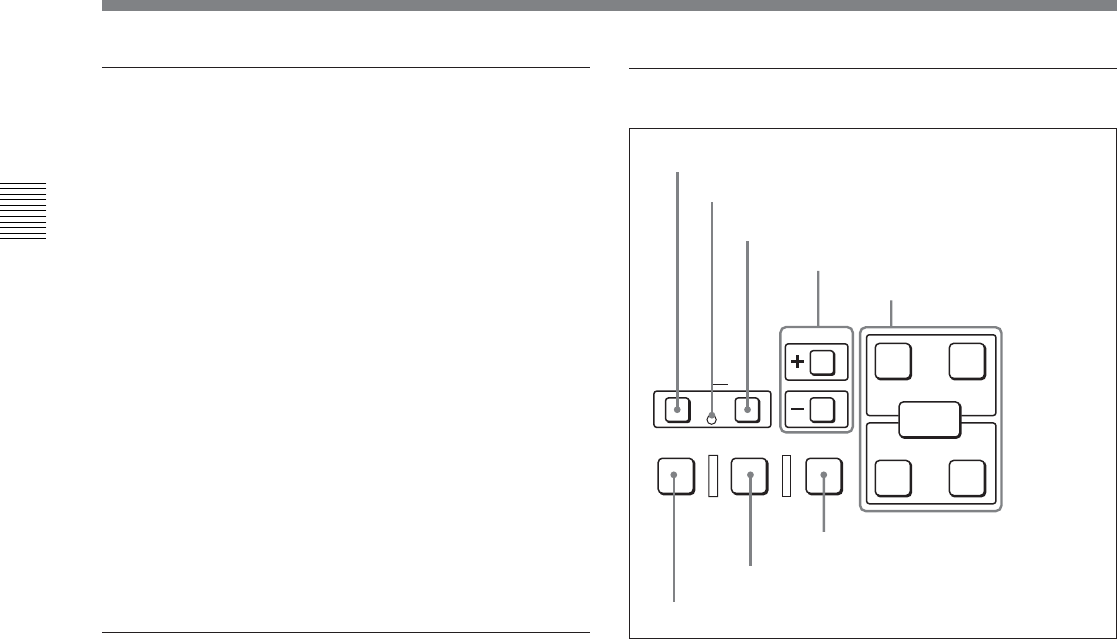
Chapter 2 Location and Function of Parts
2-12 Chapter 2 Location and Function of Parts
qd Editing control section
1 DMC EDIT button
Use this button to memorize the playback speed varied
between –1 and +2 times normal speed, and carry out
automatic playback or automatic editing using the
memorized playback speed.
2 MEMORY indicator
When memorizing the playback speed using the DMC
EDIT button, this indicator flashes as the playback
speed is captured to memory, and lights continuously
once the speed is captured.
3 DELETE button
This deletes an existing edit point.
Hold down this button and press the IN, OUT, AUDIO
IN, or AUDIO OUT button which is lit, indicating an
existing edit point, to delete the corresponding edit
point. The button either goes off or flashes. When the
button flashes, it is necessary to set the deleted edit
point again.
To cancel the DMC mode, hold down the DMC EDIT
button and press the DELETE button.
1 DMC EDIT button
ENTRY
IN OUT
IN OUT
AUDIO
DMC EDIT
PREVIEW REVIEWAUTO EDIT
DELETE
MEMORY
TRIM
2 MEMORY indicator
3 DELETE button
4 TRIM buttons
5 Edit point setting buttons
8 PREVIEW button
6 REVIEW button
7 AUTO EDIT button
qa ALARM indicator and KEY INHI
indicator
ALARM indicator
This lights when a hardware error is detected on the
unit, and goes off when the error is resolved.
When this indicator is lit, an error message appears in
the time data/menu display section. If you are using
the HDSDI OUTPUT 3 (SUPER), SDI OUTPUT 3
(SUPER) or COMPOSITE VIDEO OUTPUT 3
(SUPER) connector, then when the setting of F4
(CHARA) in function menu page 4 is ON, the error
message also appears on the monitor screen.
For details on error messages, refer to Section 1-24 in the
Maintenance Manual Volume 1.
KEY INHI (inhibit) indicator
This indicator lights when the KEY INHI switch on
the switch panel (see page 2-14) is set to ON.
qs PLAYER button and RECORDER
button
When you carry out editing using a VTR connected to
the REMOTE 1-IN(9P) or REMOTE 1-OUT(9P)
connector (see page 2-18) as the player and this unit as
the recorder, these buttons select which VTR the
editing control buttons and tape transport buttons on
this unit control.
PLAYER: The editing control buttons and tape
transport buttons on this unit control the external
player VTR.
RECORDER: The editing control buttons and tape
transport buttons on this unit control the recorder
(this unit).
When this unit is being used in standalone mode,
neither button functions.
2-1 Control Panels



